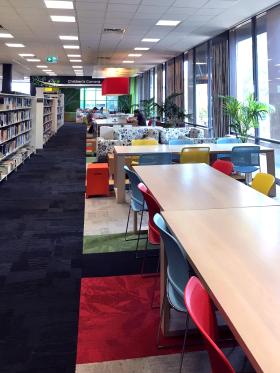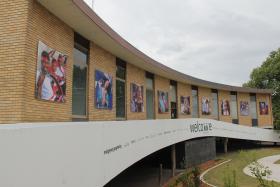Influence: Library as community place
Public libraries are valuable spaces as community hubs.
Libraries provide respectful, supportive and safe places where people can come together to participate in events and programs, express themselves creatively or simply just sit and ‘be’ with other people. Libraries assist social cohesion and cross-cultural understanding through enhancing positive social interaction. This can be of value to all members of the community but may be particularly helpful for vulnerable members of the community such as some older and younger people or those with a disability, itinerant workers, people newly arrived from overseas, and especially homeless people. For vulnerable groups, social capital is particularly important as it helps to build bridges of support with other members of the community and promotes inclusiveness.
Community living rooms

The notion of libraries as community living rooms signifies a departure from the function and atmosphere of libraries of the past. Floor space, once dominated by the collection, is converted to include comfortable areas to relax and socialise. Like public squares and street cafes, a modern public library provides a place for people to meet and pass time, in addition to its core information services.
These libraries offer a variety of different spaces – quiet contemplative nooks, places by the window, or seats near bustling thoroughfares. As well as continuing to serve their traditional roles, libraries act as an extension of people’s recreational time. People may stay for much longer periods and therefore seek the amenity that longer stays require. No activity is mutually exclusive, with visitors choosing to undertake a range of activities whilst in the library. As library spaces become more flexible and adaptable, the number and type of uses they offer expands, attracting a greater diversity and number of users.
Valuing the local
In an increasingly complex global society there is a significant shift to recognise the value of locally-based institutions that respond to local community needs. The rise in the sharing economy is characterised by people’s enthusiasm for collaboration and building connections. Libraries are perfectly placed to act as facilitators of sharing, creativity, knowledge, innovation and social responsibility.
A trusted source
In contemporary society, where information sources are so varied in origin and veracity, libraries are known as valuing the integrity of information. Skilled staff assist people to identify and critically examine sources, and ensure information is equally accessible to all members of the community. Libraries are trusted, local civic institutions. They are non-partisan, inclusive and highly valued. Libraries share a common link and interest in the wellbeing of their local communities. People bond with libraries as children and those positive associations can form the platform for a lifelong association through adulthood and old age.
Connecting culture

Public libraries provide a community with a cultural focal point. They may collect and share information about local Indigenous people and the local community’s heritage, as well as details about local activities, community groups and cultural events.
Some libraries support and display community art projects and promote information about council and government services. Developments in user generated content provide libraries with a platform to access, contribute to and assist in the collection of local information. Inclusion of artworks in public libraries and other public buildings, commercial developments and public open spaces, highlights the importance of this movement to connect a building with its community through culture.
Changing communities
The importance of demographic trends and local needs is well understood by library staff. Recent demographic and social changes, such as the ageing population, and increasing cultural diversity and migration (both internal and from overseas), have significant implications for planning and programming library spaces. Statistics and community mapping tools need to be analysed regularly and community consultation undertaken to monitor ongoing community changes.
Most communities are experiencing change. An increasing number of retirees are moving to coastal NSW. Decentralisation is occurring as people are leaving Sydney to regional areas where the cost of living is more affordable. Many areas in rural NSW are suffering from declining populations and a changing economic base. Services, such as banks and government offices, may close in these communities, possibly adding to the declining employment base and resident population.
Ageing population
Australia's older generation (those aged 65 and over) continues to grow and is projected to more than double by 2057. This will have an impact on library services, with demand for certain programs and home library services increasing. Libraries may also have a role in helping the ageing population maintain their independence and physical and mental health, as well as preventing isolation and loneliness.
Urban households
In the Sydney metropolitan area apartment living is increasing, as is the number of single person households. With a trend towards an increasing number of smaller households, the risk of social isolation increases. Public libraries can offer an alternative setting for homework, study, children’s playtime, general recreation and social interaction.
Virtual study and workplaces
More people are working from home, running their own business or taking advantage of flexible workplace arrangements. Some will be using, or want to use, co-working spaces. Video and teleconferencing are becoming the norm in many workplaces and these facilities are often needed by those who are not located in an established office space. People will work wherever it is convenient and where there are quiet spaces, collaboration and meeting areas, and free Wi-Fi – their local library.
Educational institutions are providing an increasingly flexible range of learning modes for both onsite and offsite students, such as online tutorials. The virtual work/studyplace is likely to be increasingly popular for employees, employers and students. Libraries need to provide learning spaces, seating and charging points, meeting and conference rooms for work, collaboration and study. ‘Space for connections’ is as important as ‘space for collections’, providing lifelong learning opportunities, creativity and collaboration.
Building planning for emergencies and adaptability
Libraries are safe places welcoming to all in the community with locations in metropolitan and regional areas. Libraries are often the first responders to community needs and are well positioned to provide support during times of emergency.
During the 2019/20 bushfires in NSW many people sheltered in their local public libraries as a place to connect with others, relax, stay out of the heat and use wi-fi and equipment to communicate with family, friends and service providers. In some instances, service providers set up in library meeting rooms, or the library became a bushfire command centre or evacuation site. Library buildings can be designed with flexibility and space to make this type of adaption and use easier. Even in times without emergencies people visit libraries to get away from extreme weather. We are likely to encounter more extreme weather in the future, another pandemic or another type of emergency altogether. It is important to have a flexible and adaptable library spaces to meet the needs of the community in the future.